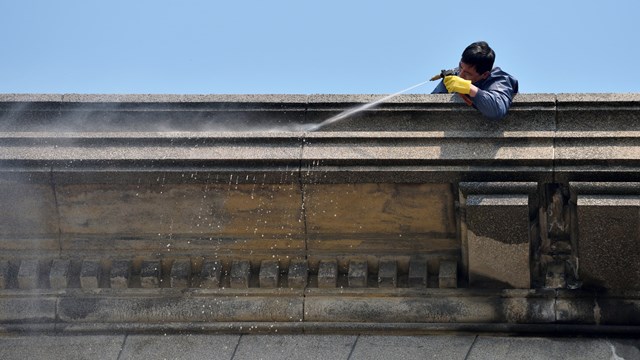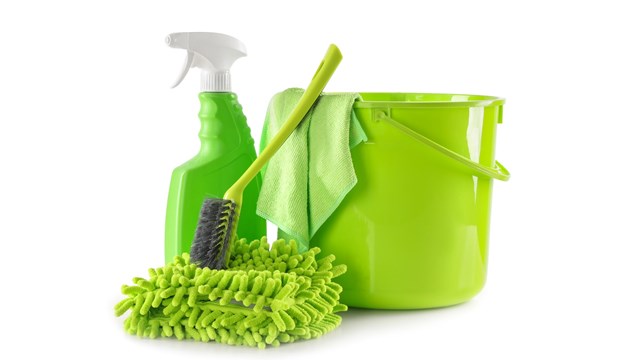Time was, if the tiles in your building’s front foyer got grimy, your super would pour some ammonia or bleach in a bucket, grab the nearest mop, and get down to business. If a drain was slow, out came the heavy-duty industrial solvents, and down the hatch. Today however, things are different in a great many buildings. There’s been a shift away from harsh, potentially dangerous cleaners and chemicals in residential buildings, and more and more boards and managers are requiring their building staff members to shelve the strong stuff in favor of gentler, less volatile “green” products.
The reasons for this shift are multiple—people are more conscious of what they put into the environment, but also about what kinds of substances they expose themselves and their families to. In the context of an urban residential building, the issue of product safety and environmental impact becomes even more pressing. It’s not just one family living in the building—there could be hundreds—so it’s more important than ever to carefully consider what types of products are being put to use in your building.
That’s Harsh
While few would argue against the many benefits of disinfectants and sanitizers, some cleaning products do have a significant downside: they may kill germs, but they pose distinct hazards to our health. The danger may be immediate—as in the case of caustic chemicals that burn the skin or cause respiratory or eye irritation upon contact—or they may be more slow-acting, contributing to long-term health problems such as cancer or disruptions of the endocrine system.
According to Philip Dickey, a staff scientist with the Washington Toxics Coalition in Seattle, the prime offenders in the first category are the corrosives, such as drain cleaners, and the many toilet and bathroom cleaning products that contain chlorine bleach or ammonia. Both bleach and ammonia give off fumes that cause eye, nose, and respiratory distress almost immediately upon exposure, but the two chemicals can be downright deadly if mixed together. When dumped into a water supply in significant amounts, their toxic effects spread farther afield.
And it’s not just the overtly toxic components of cleaning products that cause trouble—the otherwise inoffensive ingredients in many cleaning products and chemicals can cause eye, nose, throat, and lung problems for people with pre-existing conditions such as asthma or other allergies.
According to a fact sheet published by the Western Regional Pollution Prevention Network, six of every 100 janitorial workers injured on the job each year are hurt by the cleaning chemicals they use. The figure suggests that ultimately, hazardous chemicals are contributing to both lost time at work and medical costs—an important point for building managers and owners to consider when thinking about switching to safer, more user-friendly products.
The Green Movement
Which brings us to green products. According to the US Environmental Protection Agency (EPA)’s website (www.epa.gov), “Green cleaning involves selecting alternative products, using those products properly, and taking other steps to reduce risks while maintaining a satisfactory level of cleanliness and disinfection.”
As more and more studies have confirmed the potential dangers of old-school cleaning chemicals and products the demand for safer, more environmentally friendly products for everyday use has increased in recent years. The movement toward green cleaning products has pushed manufacturers to develop new products—ones that do the job just as well (if not better) than their traditional counterparts, but with far less potential for harm.
As an example, consider the commercial degreaser. According to the Environmental Choice Program, an Ottawa-based nonprofit group devoted to identifying and promoting environmentally friendly products across North America, “green” degreasers “are biologically based compounds containing enzymes and/or microbial cultures which promote microbial digestion of hydrocarbons, organic contaminants and other undesirable substances,” as opposed to the highly corrosive, older-generation products. Other more earth- and people-friendly products use natural, biodegradable ingredients like vinegar, baking soda, and citrus to do the dirty work.
Comparing the movement toward environmentally conscious household products to the recent embrace of whole foods and organic cooking, Stephen Ashkin, president of the Bloomington, Indiana-based Ashkin Group says, “Many people buy organic, free-range chicken because they feel it tastes better. But generally it’s not so much the taste that benefits people, but the fact that the [organic, free-range] chicken is better for their health.”
In addition to consumer demand, the green movement in the janitorial cleaning industry has been driven in part by relatively recent federal initiatives requiring government agencies and institutions to practice healthier and more eco-friendly working conditions in their own buildings. Agencies like the EPA and the U.S. Green Building Council (USGBC) have developed regulated product guidelines for the janitorial supply distributors with whom they have contracts, and such initiatives have trickled down to “civilian” consumers as well.
Making the Switch
Even if your building is more than ready to switch from older-generation cleaning products to the newer, more environmentally conscious ones, some questions are bound to come up—such as, What’s the first step? What’s available? And perhaps most importantly, how well do these products do the job?
The first step in switching to green products in your building is to identify your options—it may be as simple as discussing alternative lines carried by the cleaning supply distributors you work with already.
As far as private residential buildings go, if the interest exists on the part of board of directors, shareholders, building owners and property managers, to become greener in their living and working establishment, they should start with educating themselves and doing their own research. New York State already mandates that all government agencies and schools use green cleaning products and services.
Franklin Cruz, president and CEO of Direct Environmental Corporation in New Jersey says that building owners and managers “should educate themselves on the subject so that they can separate fact from fiction. Naturally, they are going to get some resistance from their existing cleaning supply company because they don’t want to lose the business. So, I think the board needs to do the necessary research.”
The second—and perhaps most vital—component of the change is to get your building staff on board with the new green standards. After all, they’re the ones who will be using the products, and will likely have many questions about their efficacy.
According to an article on transitioning to green products by Thomas Barron, Debbie Raphael, and Lara Sutherland for Pollution Prevention Review, “[Switching to] environmentally preferable (EP) products inevitably involves a process of behavior change. End users such as mechanics, custodians, and office staff have been using traditional products for many years, and are often satisfied with their results. When managers suggest a switch to EP products, they are usually met with resistance simply because any change is difficult, and it is human nature to resist change. Yet behaviors can be changed, and attitudes towards new products and systems improved. Behavior change involves much more than just issuing a carefully-worded policy statement or telling janitors to switch Product A for Product B.”
The authors continue, pointing out that “attitudes like ‘If it doesn’t smell like bleach it won’t clean,’ and ‘If it’s got the word environmental on the label, it must be weak,’” are common, and must be addressed head-on. After all, any change that requires more effort to achieve the same effect will likely be met with little enthusiasm by busy staff members.
“The industry is going through an evolution,” says Cruz, “and there seems to be a struggle between producing a product that is going to work [versus something easier on the environment]. For example, there are certain floor strippers that could strip wax from a floor much more effectively than a green cleaning product might. For those whose goal is to get it done a little more efficiently, a little faster, they may not want to use the green equivalent, because it may require more than one application.”
“No matter how well worded the policy or how effective the product,” add authors Thomas, Raphael, and Sutherland, “if the people implementing the change do not believe in the program, all efforts are doomed to fail. These attitudes can also result in overuse of product, a practice that is potentially harmful to the user and is not good for the environment.”
That’s why it’s important to get your super and/or head porter on board with your green product initiative from the get-go. He or she can then train the rest of the building staff in the proper use of the new products, say the authors. Also, enlisting staff members to test new products before they’re ordered in bulk is a great way to address a number of issues: it allows staff members to be part of the decision, as well as determining the best products for your building’s needs.
“Including these end-users early on in product selection and testing will turn skeptics into stake-holders. End-users often become the best trainers, and should be used as models of success.”
Regardless of what products your building settles on in the end, one thing may come as a surprise. According to Peter Grech, president of the New York Superintendents Technical Association (STA), OSHA regulations require buildings to keep the chemical composition of every chemical compound on the premises on permanent file. It doesn’t matter how gentle or innocuous a product seems—federal regulations state that this information be easily accessible to residents and employees for both safety and liability reasons.
Green Resources
Mike Sawchuck of Enviro-Solutions encourages building owners and managers to “talk to [their] janitorial distributors and ask for more information on green cleanings, or visit the websites of the Building Owners and Managers Association (BOMA) and the USGBC.”
While working with your current janitorial supplier is probably the quickest way to identify your green cleaning options, lots of other resources exist to help buildings integrate greener products into their daily cleaning roster. Here are just a few:
• The Green Cleaning Pollution Prevention Calculator (www.ofee.gov/janitor). The EPA developed this tool to estimate the benefits to be achieved by adopting “green” cleaning practices.
• Green Seal: (www.greanseal.org). Green Seal is an independent non-profit organization dedicated to safeguarding the environment and transforming the marketplace by promoting the manufacture, purchase and use of environmentally responsible products and services.
• The U.S. Green Building Council (www.usgbc.org)
• The Environmental Choice Program (www.environmentalchoice.com)
• U.S. Department of Labor Occupational Safety & Health Administration (www.osha.gov)
At these sites consumers, purchasers—both retail and wholesale—can research green product information, certification programs and news and articles related to green building practices.
Is Green Worth It?
Many building owners and managers may be wondering if all the research and work is really worth it. According to Ashkin, “Why take the risk? Twenty or 30 years ago, some of these compounds were the only things we had available. We just need to become more informed consumers and make better-educated decisions. If people will buy [green products], manufacturers will make them. Consumers need to become more educated and realize that they can make a difference—to both their health and in terms of protecting the environment. That’s what the green cleaning movement is really all about.”
Hannah Fons is Associate Editor of The Cooperator. Additional reporting by Gillian Kalson.







Leave a Comment